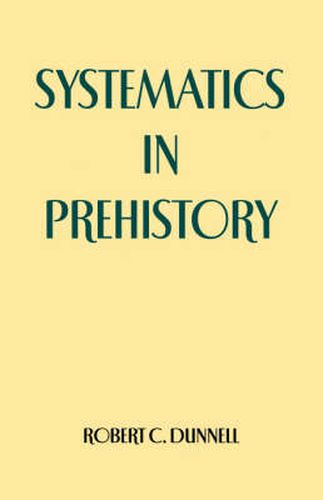Readings Newsletter
Become a Readings Member to make your shopping experience even easier.
Sign in or sign up for free!
You’re not far away from qualifying for FREE standard shipping within Australia
You’ve qualified for FREE standard shipping within Australia
The cart is loading…






Systematics in Prehistory was originally published in 1971. It soon became an essential book for anyone who wished to understand the principles of classification and how they are applied in archaeology. The book clarifies differences among the various kinds of classification (paradigmatic, taxonomic) and discusses the appropriate uses of each. It also discusses groups and grouping devices and how they differ from classification. This continues to be an area of considerable confusion in archaeology. This book is as useful to graduate students and professionals in archaeology now as it was 30 years ago. Its materials have not become dated nor have they been superceded by more recent treatments. This work remains a crucial foundation for knowledgeable application of systematics in archaeology. Dunnell’s primary goal was to develop a conceptual framework for the study of prehistory based on systematics. Part I of the book provides an introduction to systematics. Here Dunnell builds a precise and beautifully consistent structure of concepts applicable to phenomena in general. Part II proceeds to illustrate the application of systematics to prehistory. The treatment is concise and rigorous. From an original review of the book in Mankind: This book makes two original contributions of considerable value to the literature of archaeological theory. First, it not only recognizes the debt which the new archaeology owes to the old archaeology but it attempts reconciliation between the two. Second, it examines with precision and rigor the basic concepts which prehistorians use implicitly and attempts to make both their usage and their definition explicit. After graduate work at Yale, Dr. Robert C. Dunnell was appointed Professor of Anthropology at the University of Washington, Seattle, where he remained for thirty years. He retains graduate training responsibilities at the University of Washington, where he is emeritus. The central intellectual theme of his career has been recreating archaeology as science. While he pursued this objective along traditional lines early in his career, by the late 1970s this recreation had led him to evolutionary theory and nearly all his published work since that time touches on evolution and its application to the archaeologic record. He is widely regarded as the principal exponent of evolutionary archaeology today.
$9.00 standard shipping within Australia
FREE standard shipping within Australia for orders over $100.00
Express & International shipping calculated at checkout
Systematics in Prehistory was originally published in 1971. It soon became an essential book for anyone who wished to understand the principles of classification and how they are applied in archaeology. The book clarifies differences among the various kinds of classification (paradigmatic, taxonomic) and discusses the appropriate uses of each. It also discusses groups and grouping devices and how they differ from classification. This continues to be an area of considerable confusion in archaeology. This book is as useful to graduate students and professionals in archaeology now as it was 30 years ago. Its materials have not become dated nor have they been superceded by more recent treatments. This work remains a crucial foundation for knowledgeable application of systematics in archaeology. Dunnell’s primary goal was to develop a conceptual framework for the study of prehistory based on systematics. Part I of the book provides an introduction to systematics. Here Dunnell builds a precise and beautifully consistent structure of concepts applicable to phenomena in general. Part II proceeds to illustrate the application of systematics to prehistory. The treatment is concise and rigorous. From an original review of the book in Mankind: This book makes two original contributions of considerable value to the literature of archaeological theory. First, it not only recognizes the debt which the new archaeology owes to the old archaeology but it attempts reconciliation between the two. Second, it examines with precision and rigor the basic concepts which prehistorians use implicitly and attempts to make both their usage and their definition explicit. After graduate work at Yale, Dr. Robert C. Dunnell was appointed Professor of Anthropology at the University of Washington, Seattle, where he remained for thirty years. He retains graduate training responsibilities at the University of Washington, where he is emeritus. The central intellectual theme of his career has been recreating archaeology as science. While he pursued this objective along traditional lines early in his career, by the late 1970s this recreation had led him to evolutionary theory and nearly all his published work since that time touches on evolution and its application to the archaeologic record. He is widely regarded as the principal exponent of evolutionary archaeology today.